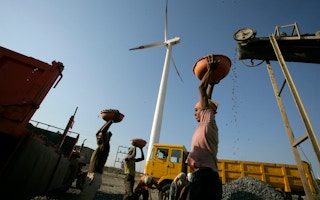Sustainable Development Goal (SDG) 7 is to ensure access to affordable, reliable, sustainable, and modern energy for all by 2030. Are we making enough progress to be on track to meet the deadline?
According to the latest estimates of the International Energy Agency, nearly 1.2 billion people have gained electricity access since 2000, and the number of people without access to electricity fell to about 1 billion in 2016. Most progress has been made in developing Asia, where around 900 million people (including 500 million in India) have gained access, and the People’s Republic of China achieved universal electrification in 2015.
However, the world is not on track to achieving sustainable energy for all. Despite positive developments, population growth and uneven progress means that some 600 million people will remain without power in 2030, 58 million of them in Asia and the Pacific.
Therefore, additional efforts will be required. In particular, there is a need to double the financing for SDG 7 globally, from the current annual level of about $500 billion to $1 trillion-$1.2 trillion per year until 2030.
But the key issue is not only about the amount of money invested—it is more important to determine what will be the right technology that can be deployed to provide electricity to the poor people mostly in rural areas. Indeed, the cost of renewable energy technologies such as solar photovoltaic (PV) and wind have declined tremendously over the last 10 years. But can they meet all the requirements to achieve universal energy access by 2030?
In other words, can we achieve SDG 7 without fossil fuels, such as coal, given that Asia and the Pacific has the highest global share of energy derived from coal?
First, the region’s coal capacity in 2016 was 1,360 gigawatts, accounting for 59 per cent of the total electricity generation. Renewable energy represented 21 per cent (hydro 15 per cent, wind 3 per cent, and solar PV 1 per cent), and other sources 20 per cent (natural gas 13 per cent, nuclear 4 per cent, oil 2 per cent). It is clear that such a large share of coal-fired power generation cannot be phased out entirely in the next 12 years.
In this sense, coal is indeed indispensable to provide electricity in Asia and the Pacific. As per the IEA’s assessment, coal will still account for 45 per cent of power generation under the “new policy scenarios” (the direction in which today’s policy and technology momentum is leading the energy system) in the region by 2030.
Second, to meet the “incremental demand” of rural electrification, conventional power systems (such as coal-fired large power plants and long-distance transmission lines) have shown their limits.
Conventional systems are cost-effective only if the electricity load is above 100 kilowatts (KW) and within 10 kilometers of the main grids. However, most of the remaining population without access to electricity lives in remote areas or islands with dispersed and small loads, where grid extension is technically and economically unviable.
Under these circumstances, minigrids and solar home systems are rapidly emerging as a viable option to provide energy thanks to technological innovations and cost reductions. Such distributed systems have the advantage of flexibility and scale in remote areas at a much lower cost than grid extension or diesel-generated power.
“
If all countries in Asia and the Pacific more aggressively pursue a low-carbon transition, then the share of coal power generation will be reduced to 25 per cent by 2030, and further decline to 10 per cent by 2040.
It should be noted that minigrids are by no means “low-tech” or temporary solutions. Minigrids are powered by solar or wind (or hybrid) with battery storage, and managed by a digital energy management systems to ensure high-quality, 24/7 power supply.
With minigrids, even blockchain technology can be envisaged to enable trading of surplus power among consumers. Such systems can cover basic energy needs such as lighting, fans, television, and refrigerators, and can be scaled up to meet higher loads for agriculture and food processing.
While fossil fuel-fired power plants—including coal—must remain in place to keep the electricity grid “up and running” in many Asian countries over the next decade or two, renewable energy-based distributed systems will be the most cost-effective ways to meet the incremental demand of rural electrification in the region.
Further, in line with the 2015 Paris Agreement on climate change, all countries have committed to reduce their greenhouse gas emissions under their Nationally Determined Contributions (NDCs). In the IEA’s “sustainable development scenario,” if all countries in Asia and the Pacific more aggressively pursue a low-carbon transition, then the share of coal power generation will be reduced to 25 per cent by 2030, and further decline to 10 per cent by 2040.
ADB’s energy policy prioritises renewable energy development through innovative technologies and approaches. We will support our developing member countries in their efforts to meet SDG 7 and comply with the Paris Agreement, and we do believe the universal clean energy access can be achieved without “new coal.”
Yongping Zhai is Technical Advisor (Energy), Sustainable Development and Climate Change Department at ADB. This post is republished from the ADB blog.









